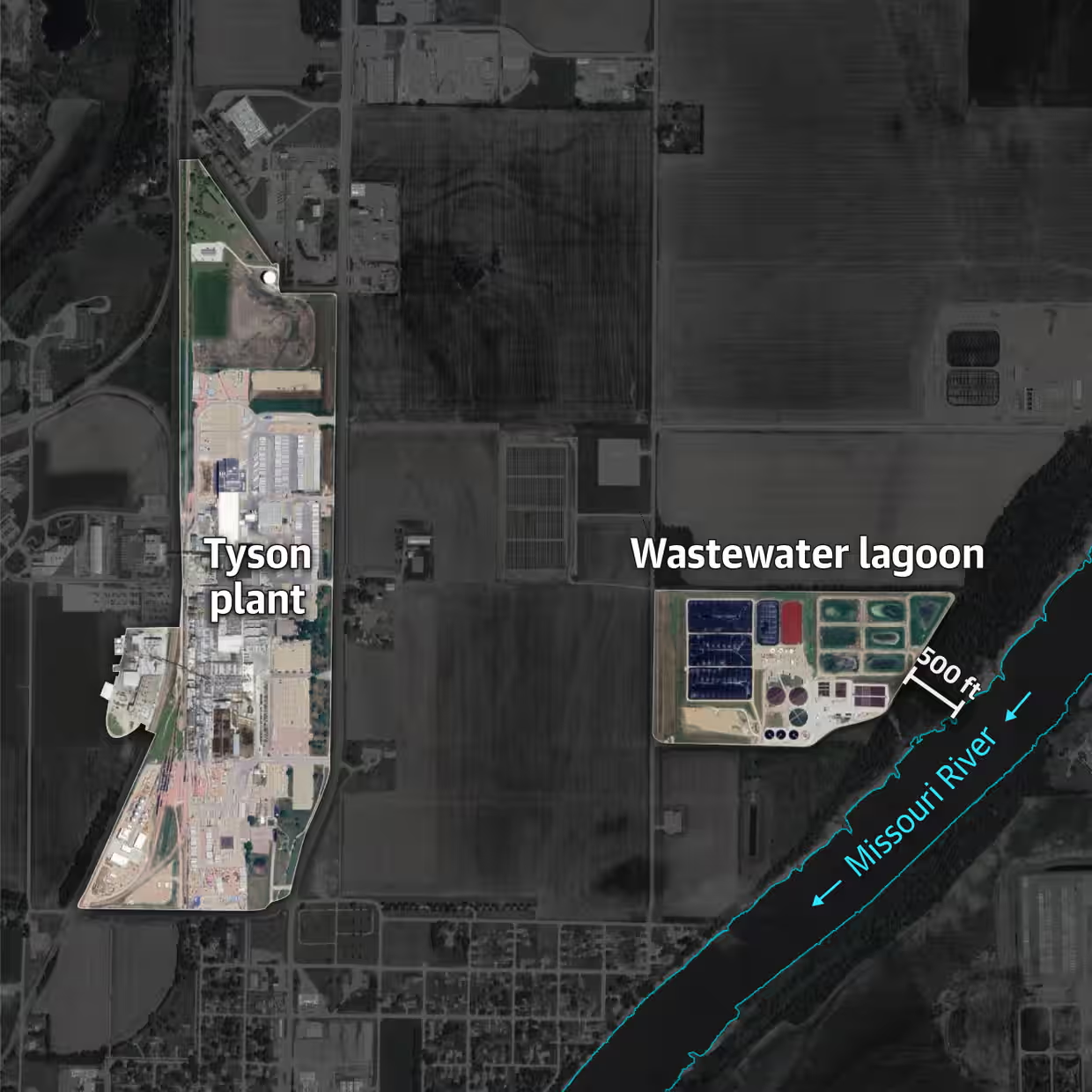And No One Is Surprised Given Tyson’s Track Record
Over the past five years, Tyson Foods has discharged a staggering 371 million pounds of harmful pollutants into U.S. rivers and lakes, posing severe risks to ecosystems, wildlife, and human health. This shocking revelation comes from a meticulous investigation into the practices of one of America’s largest meat producers.
Among the toxic substances released are nitrogen, phosphorus, chloride, oil, and cyanide, all emanating from 41 of Tyson’s facilities across the country. The Union of Concerned Scientists (UCS), which conducted the study, points out that these pollutants were part of 87 billion gallons of wastewater—also laden with blood, bacteria, and animal feces—flowing directly into crucial water bodies that provide drinking water and are used for fishing and recreation.

The Magnitude Is A Horror Show
The volume of contaminated water is enough to fill approximately 132,000 Olympic-sized swimming pools, a stark illustration of the scale at which these pollutants are being emitted. Primarily affecting states like Nebraska, Illinois, and Missouri, the pollution exacerbates the existing environmental strain from industrial agriculture prevalent in these regions. Such practices are notorious for fostering harmful algal blooms that disrupt water infrastructure, aggravate respiratory conditions, and suffocate marine life by depleting oxygen levels.
“Water is our most important resource, and the Missouri River is very important to our culture and people,” said Aaron LaPointe, a member of the Winnebago tribe.
Regulatory Gaps and Corporate Impunity
Despite the alarming figures, current federal policies are of no help. Phosphorus limits are nonexistent, and a vast majority of meat processing facilities aren’t even subject to stringent water regulations. This oversight permits an unchecked flow of toxins into natural waterways.
There are over 5,000 meat and poultry processing plants in the United States, but only a fraction are required to report pollution and abide by limits. As one of the largest processors in the game, with a near-monopoly in some states, Tyson is in a unique position to treat even hefty fines and penalties for polluting as simply the cost of doing business. “This has to change,” remarked Omanjana Goswami, co-author of the UCS study.
The Environmental Protection Agency (EPA) is at a crossroads, deciding whether to adopt robust new regulations or succumb to the preferences of the influential meat-processing industry. Advocates for environmental protection and legal experts are calling for updated regulations that align with modern environmental challenges.
Dani Replogle of Food and Water Watch emphasized, “The current rule is out of date, inadequate and catastrophic for American waterways, and highlights the way American lawmaking is subject to industry capture.”

“We’ve created a system with no accountability that doesn’t protect our ecosystem – which includes the land, water and people of Nebraska,” stated Graham Christensen, a regenerative farmer.
The Power of Lobbying
The meat-processing sector, with Tyson at the forefront, carries heavy influence in Washington, spending millions on lobbying and campaign donations.
This financial clout is a major barrier to stringent environmental regulations that would protect waterways and communities from industrial pollution.

Local and Cultural Impacts
In Nebraska, where agriculture dominates, the local and cultural impacts of water pollution are profound. Indigenous communities and small, family-owned farms express concerns about the sustainability of their practices and the health of their lands and waters.
More To Discover
Tyson’s operations, particularly its largest plant in Dakota City, have been linked to severe environmental and health issues, contaminating the Missouri River—a vital resource for millions.
Advocates, scientists, and concerned citizens argue for stronger state and federal regulations to curb the environmental damage caused by large agribusinesses like Tyson. The ongoing pollution not only threatens the health of local communities and ecosystems but also poses long-term risks to biodiversity and the sustainability of natural resources.
8 Things You Should Know About This Topic
- Scale of Pollution: Tyson Foods released 371 million pounds of pollutants into U.S. waterways over five years, including harmful substances like nitrogen, phosphorus, chloride, oil, and cyanide.
- Impact on Ecosystems: These pollutants contribute to algal blooms and deplete oxygen levels in water, endangering marine life and disrupting ecosystems that are crucial for fishing, recreation, and drinking water supplies.
- Regulatory Shortcomings: Current federal regulations lack specific limits for phosphorus and exempt many meat processing plants from stringent water pollution controls.
- Disproportionate Impact: About half of the contaminants were dumped in Nebraska, Illinois, and Missouri, highlighting regional environmental stress particularly in the Midwest.
- Volume of Wastewater: The pollutants were part of 87 billion gallons of wastewater, sufficient to fill approximately 132,000 Olympic-sized swimming pools.
- Corporate Influence: Tyson Foods, as a major player in the meat-processing industry, has spent significant amounts on lobbying and political donations, influencing regulatory frameworks and environmental policies.
- Upcoming EPA Regulations: The EPA is expected to update its pollution standards by September 2025, facing pressure between adopting stricter regulations or yielding to industry-favored weaker standards.
- Community and Cultural Impact: Local communities, especially in agricultural regions and indigenous tribes, are severely affected by the pollution, impacting their health, culture, and local economies.



















